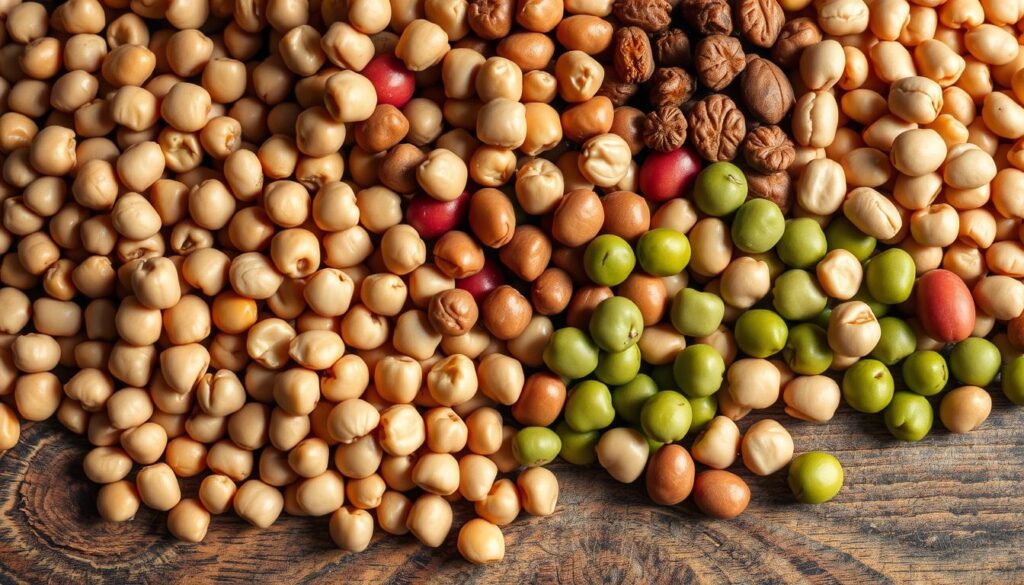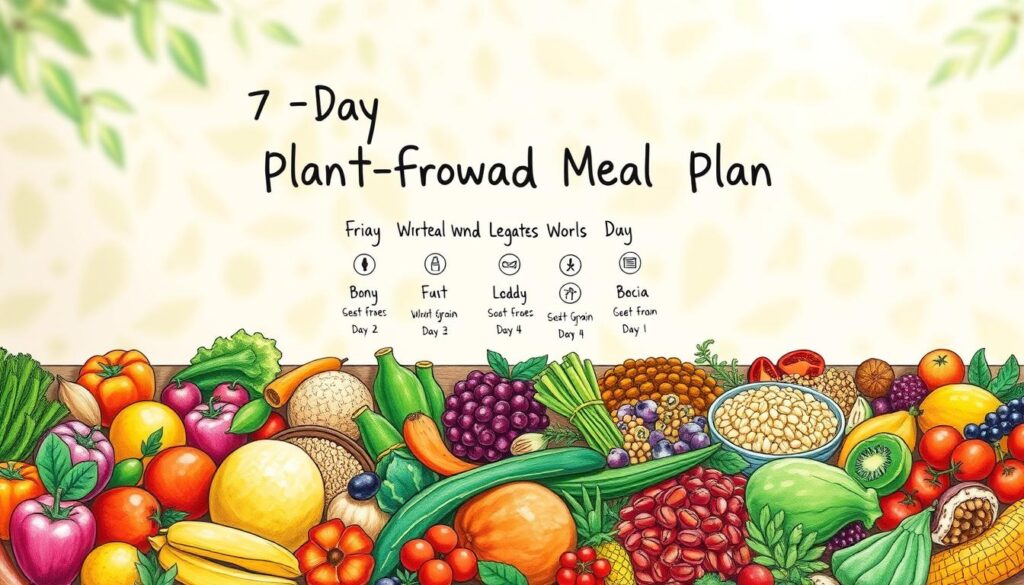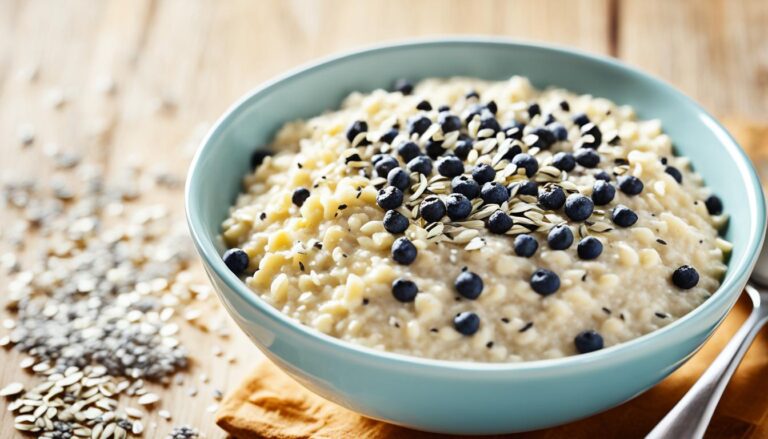Can the meals you choose in mid life really change how you age? A 30 year analysis of over 105,000 U.S. adults suggests the answer is yes.
Higher adherence to high quality eating patterns rich in plant foods linked to better odds of intact cognition mobility mood, and reaching age 70 free of major chronic disease.
This introduction previews an evidence based guide that turns long running cohort findings into practical U.S. friendly meal plans grocery swaps and weekly strategies. The Alternative Healthy Eating Index showed the strongest tie to good outcomes while ultra-processed foods cut odds of aging well by about 32%.
The guide clarifies that a plant-forward approach prioritizes plants without requiring full exclusion of animal items. Expect clear steps to lower ultra processed intake favor whole grains nuts legumes, and unsaturated fats, and use simple cooking tips to protect nutrients.
Key Takeaways
- Mid-life food choices shape cognitive, physical, and mental aging.
- Higher-quality patterns AHEI, Mediterranean link to better outcomes.
- Cutting ultra processed foods supports long term health.
- Plant-forward does not mean fully vegan; flexibility works.
- The guide will offer practical, U.S.-ready meal plans and swaps.
Why Healthy Aging Starts With What You Eat
Daily food choices act like small investments that compound into big differences in later-life health.
Diet quality is a top behavioral risk factor for noncommunicable disease and early death. The World Health Organization frames aging as preserving function and preventing decline, which makes nutrition central to long term health.
Eating patterns influence vascular, metabolic, and neurological systems at once. Nutrient-dense foods lower cardiometabolic markers, improving strength, mobility, and resilience over time.
- Fiber, antioxidants, and unsaturated fats support insulin sensitivity, endothelial function, and brain health.
- Poor choices speed low-grade inflammation and oxidative stress that wear down cells and tissues.
- Diet alters skin and connective tissue via antioxidant status and glycation load, linking nutrition to visible signs of aging.
Think of food as both medicine and potential toxin, depending on composition and processing. Consistent high quality intake matters far more than episodic fads.
Good nutrition complements exercise, sleep, and other habits. Later sections translate this evidence into pantry swaps, meal plans, and simple routines that stack benefits year after year.
Defining Plant Focused Diets vs. Vegan and WFPB
Choosing a mostly plant-centered eating plan shifts the focus from labels to the foods on your plate.
Plant forward means prioritizing vegetables fruits, whole grains, legumes nuts, and seeds while not mandating total exclusion of meat or dairy. This flexibility helps people adopt better patterns without dramatic cultural change.
A whole food plant-based WFPB plan, as defined by Kaiser Permanente, emphasizes vegetables, fruits, beans, lentils nuts, seeds whole grains, and small amounts of healthy fats. It excludes animal products and most processed sweets or refined ingredients.
How vegan and WFPB differ
Vegan diets eliminate animal products but can still include processed oils, sugars, and refined flours. That can lower overall nutrient density despite the label.
| Approach | Key features | Typical benefit |
|---|---|---|
| Plant-forward | Mostly whole plants; modest fish, poultry, dairy optional | Practical adherence; aligns with AHEI and Mediterranean patterns |
| Vegan | Removes animal products; product choices vary in processing | Ethical/environmental aims; nutrient outcomes depend on planning |
| WFPB | Whole, minimally processed plant foods; excludes most processed products | Higher antioxidant and fiber intake; links to telomere and skin benefits |
- Focus on nutrient density and processing level these matter more than labels.
- Whole plant foods deliver fiber, polyphenols, vitamins, and minerals that support metabolic and vascular health.
- Later sections cover fats, low AGE cooking, and weekly menus to translate these ideas into practice.
What the 30 Year Evidence Shows About Mid Life Diet and Aging
Thirty years of follow-up in two major U.S. cohorts reveal clear links between mid-life eating and later-life function.
Inside the Nurses’ Health Study and Health Professionals Follow Up Study
Two cohorts the Nurses’ Health Study women and the Health Professionals Follow Up Study men tracked 105,015 participants. Mean baseline ages were 53 ± 8 years, and repeated dietary assessments spanned up to 30 years of follow-up study.
Healthy aging outcomes cognitive physical mental and disease free longevity
The research used a composite metric that required intact cognition, preserved physical function, good mental health, and reaching at least age 70 free of 11 major chronic disease.
Key finding higher adherence to healthy patterns improved odds of healthy aging
Headline findings: 9,771 participants 9.3% met the healthy outcome. Odds ratios for highest versus lowest pattern adherence ranged from 1.45 hPDI to 1.86 AHEI. With a stricter age cutoff of 75, AHEI rose to an OR of 2.24 (2.01–2.50).
- Domain results: 33.9% kept cognitive function; 28.1% kept physical function; 26.5% kept mental health; 22.8% stayed disease-free; 37.9% reached age 70.
- Benefits tied to fruits, vegetables, whole grains, nuts, legumes, unsaturated fats, and low-fat dairy. Harmful items included trans fats, high sodium, sugary drinks, and red/processed meats.
- Higher ultra-processed food intake linked to ~32% lower odds of healthy aging, independent of activity, smoking, and BMI.
Plant Focused Diets and Healthy Aging Core Takeaways From Research
Thirty-year evidence from U.S. cohorts clarifies which habitual patterns best predict later-life function.

AHEI leads; hPDI shows smaller but positive links
Key finding: Highest quintile adherence improved odds of healthy aging. The Alternative Healthy Eating Index (AHEI) had the strongest association OR up to 1.86; 2.24 at age 75. The healthful Plant Based Diet Index (hPDI) also showed positive links, but they were weaker than AHEI.
Which foods drive the benefit
Across patterns, the core drivers were clear. Fruits vegetables, whole grains, nuts, legumes, and added unsaturated fats aligned with better outcomes. Polyunsaturated fatty acids showed consistent ties to survival to age 70 and preserved cognition and mobility.
- Neutral-to-beneficial: low fat dairy included in top scoring patterns.
- Limit: trans fats, excess sodium, sugar-sweetened drinks, and red/processed meats.
- Practical note: differences between scores reflect both composition and scoring rules; pick a pattern you can sustain.
These findings connect directly to later sections with shopping lists, meal assembly, and weekly routines to support long-term adherence.
Which Eating Patterns Work Best for Healthy Aging?
Not all dietary indexes deliver the same mix of benefits; each highlights different pathways to long-term health.
The Alternative Healthy Eating Index AHEI came out strongest overall. AHEI showed the biggest links to preserved physical and mental function in the cohort analysis.
The plant forward PHDI scored highest for cognitive outcomes and survival to age 70. It emphasizes plant protein and whole foods, which may lower cognitive risk.
The reduced empirical dietary inflammation/insulin indices rEDIH/rEDIF tied most closely to being free of major chronic disease. They focus on foods that influence inflammation and insulin pathways.
The MIND score targets brain health with leafy greens and berries, while DASH prioritizes sodium reduction to protect blood pressure and vascular risk.
The aMED or mediterranean diet highlights extra-virgin olive oil, fish, and nuts; modest fish intake fits well within a plant-centered plate and supports cardiometabolic markers.
hPDI, although beneficial, ranked lower than other indices. That suggests adding specific healthy animal foods or emphasizing unsaturated fats can boost associations in some domains.
Choosing a pattern that works
- Select an index you can sustain consistency across years matters more than perfection.
- Core elements to keep: whole plants, whole grains, legumes, nuts, and unsaturated fats.
- Minimizing ultra processed foods improves scores across all indexes and supports better outcomes
The Role of Ultra Processed Foods in Accelerated Aging
Ultra-processed foods now loom large in U.S. grocery carts and may speed biological decline.
Definition and impact: Ultra processed products are industrial formulations with additives refined ingredients, and little whole food structure. Long term research found that highest versus lowest consumption tied to a 32% lower chance of reaching older adulthood with intact function.
Common culprits and what to watch for
Frequent U.S. examples include sugary beverages, packaged snacks, sweet baked goods, processed meats, instant noodles, frozen entrées, and ready-to-eat cereals with long ingredient lists.
- Mechanisms: UPFs promote overconsumption, raise sodium and added sugars, lower fiber and micronutrients, and may increase inflammation.
- Label cues: long ingredient lists, many emulsifiers, artificial colors/flavors, and refined flours are red flags.
Practical swaps and systems
Choose seltzer or unsweetened tea instead of soda. Pack nuts and fruit instead of candy bars. Pick whole grain oats over flavored instant packets.
Behavioral tips: Batch cooking and simple scratch-prep cut reliance on convenience products. Reducing UPF exposure improves scores on AHEI, DASH, aMED, MIND, and PHDI strengthening multiple dietary goals over time.
| UPF Category | Typical issues | Smart swap |
|---|---|---|
| Sugary beverages | High added sugar low nutrients | Unsweetened tea or seltzer |
| Packaged snacks sweets | Refined grains added fats/sugars | Nuts, seeds, whole fruit |
| Ready meals processed meats | High sodium; additives | Simple grain bowls or roasted legumes |
Mechanisms That Matter Inflammation Insulin, and Oxidative Stress
What we eat shapes inflammation and insulin signaling, which drive tissue aging over decades.
How patterns alter core biology: Low-quality dietary patterns raise chronic inflammation and disrupt insulin responses. These changes harm blood vessels, nerve cells, and muscle, increasing risk for later disease and decline.
Fiber helps blunt post-meal glucose swings and feeds gut microbes. Those microbes make short-chain fatty acids that lower inflammation and support metabolic health.
Polyphenols from fruits, vegetables, whole grains, legumes, tea, and cocoa limit oxidative stress and calm inflammatory signaling. Recent studies link higher polyphenol intake to better cognition and mobility.
Unsaturated fats especially PUFAs and MUFAs improve lipid profiles, boost endothelial function, and stabilize cell membranes. These nutrients help preserve physical and cognitive function and support survival to older ages.
| Mechanism | Dietary action | Practical choice |
|---|---|---|
| Chronic inflammation | Lower with fiber, polyphenols | Whole fruit, legumes, vegetables |
| Insulin dysregulation | Reduce refined carbs and added sugars | Whole grains, beans, nuts |
| Oxidative stress | Buffer with antioxidants and healthy fats | Olive oil, fatty fish, green tea |
EDIP and EDIH score patterns mirror these pathways: favor whole plants and healthy fats while cutting refined starches, sweets, and processed meats. Habitual changes over years compound gains in aging outcomes.
Antioxidants and Cellular Protection
Antioxidants form a frontline defense that keeps cells and skin resilient across decades.
How the cascade works: Vitamin E protects lipid membranes, vitamin C regenerates vitamin E, and vitamin A derivatives quench singlet oxygen. This cascade protects skin lipids and cell membranes from reactive oxygen species that rise with aging.
Whole plant foods deliver far more antioxidant density than animal products about 64x on average so a varied plate boosts systemic defense in the body. Dietary choices that favor colorful produce support long-term cellular resilience.
Polyphenols, chlorophyll and CoQ10
Polyphenols like cocoa flavanols and berry polyphenols emphasized in the MIND pattern can improve skin elasticity and reduce wrinkle depth in controlled studies. One 24-week study showed measurable gains in dermal matrix integrity with flavanol intake.
Chlorophyll and chlorophyllin may bind some dietary carcinogens and, with sunlight, help regenerate CoQ10. CoQ10 supports mitochondrial energy and skin structure a 12-week supplementation study reported improved firmness and fewer wrinkles.
| Antioxidant | Main role | Top food sources |
|---|---|---|
| Vitamin E | Membrane protection | Nuts, seeds, vegetable oils |
| Vitamin C | Regenerates E antioxidant | Citrus, peppers, berries |
| Polyphenols / CoQ10 | Matrix support mitochondrial | Berries, cocoa, fatty fish, spinach |
| Chlorophyll | Bind mutagens support CoQ10 | Leafy greens, green juices |
Practical note: Include deeply colored fruits, leafy greens, carrots, and tomatoes daily. Dietary antioxidants strengthen cellular defense but do not replace sun protection or other lifestyle measures. Repeated, modest intake over years compounds protection and helps lower AGE burden and inflammation tied to aging.
Gerontotoxins and AGEs What They Are and How to Avoid Them
When food browns under high heat, it can produce AGEs that later show up as stiffer arteries and less elastic skin.
Advanced glycation end products AGEs form when sugars bind to proteins or fats without enzymes. These compounds accumulate in collagen and elastin. Over years they impair repair, reduce skin elasticity, and stiffen vessels.
High AGE dietary sources include processed products, high fat animal items, and especially meat with red meat and processed meats ranking highest. Ultra-processed items also carry many AGEs.
Cooking matters. Dry heat methods grilling roasting broiling, frying raise AGE loads. Moist heat techniques steaming poaching stewing, pressure cooking lower them.
- Choose legumes, whole grains, and vegetables prepared with moist heat to cut AGE exposure.
- Marinate with lemon, vinegar, herbs, or antioxidant rich spices to blunt AGE formation.
- Trim charred bits and skip high-sugar glazes that promote glycation.
AGEs interact with UV exposure and smoking to accelerate aging and raise disease risk. Long-term, consistent reductions in dietary AGEs along with fewer UPFs and better fats strengthen skin and vascular health a point supported by recent studies.
Healthy Fats for Aging Well PUFAs and MUFAs
Fats that favor unsaturated profiles offer clear benefits for skin, metabolism, and long-term function.
ALA EPA DHA Skin integrity and inflammation control
Alpha-linolenic acid ALA is an essential omega-3 found in flax, chia, walnuts, and canola. The body converts some ALA to EPA and DHA, which help reduce skin inflammation and protect against UVB damage.
Higher omega-3 intake links to less photoaging, reduced skin dryness, and lower systemic inflammation. If conversion is limited modest direct EPA/DHA from fish or algae supplements is a practical option for many.
EPA and DHA reduce skin inflammation and may blunt UVB-induced damage.
MUFAs from olive oil and nuts heart and skin benefits
MUFAs especially from extra virgin olive oil, avocados, and many nuts may lower oxidative stress and improve insulin sensitivity. Several studies associate olive oil intake with milder skin aging signs and better cardiometabolic markers.
- Practical swaps: use olive oil instead of butter; tahini or nut butter in place of creamy dressings; fatty fish or tofu rather than processed meats.
- Nuts deliver MUFAs/PUFAs plus fiber, minerals, and polyphenols for combined benefit.
- Within a Mediterranean style pattern, modest fish intake boosts EPA/DHA while keeping the plate plant-forward.
| Fat type | Sources | Benefit for aging |
|---|---|---|
| ALA plant omega-3 | Flaxseed, chia, walnuts, canola | Supports EPA/DHA status linked to lower skin aging markers |
| EPA/DHA marine | Fatty fish, algae oil | Reduces skin inflammation protects against UVB damage |
| MUFAs | Olive oil, avocados, many nuts | Improves insulin response lowers oxidative stress skin and heart benefits |
| Risks to limit | Trans fats, high saturated animal fats, ultra processed spreads | Raise inflammation and heart disease risk |
Cohort data showed added unsaturated fats associated with better survival and preserved function. Balance total calories while prioritizing fat quality to support long-term disease risk reduction and skin resilience.
Putting It Into Practice U.S.-Friendly Meals and Grocery Lists
A clear grocery plan helps translate research into consistent affordable eating.
Daily targets AHEI inspired: aim for 5+ servings of vegetables, 4 servings of fruits, and 5–6 servings of whole grains. Add one daily serving from nuts, legumes, or another plant protein to meet dietary goals that link to better aging odds.
Staples to keep on hand
- Whole grains: oats, brown rice, quinoa, whole-wheat pasta
- Legumes: canned beans, lentils, chickpeas (low-sodium when possible)
- Vegetables & fruits: leafy greens, crucifers, berries, citrus
- Nuts, seeds, olive oil, low-sodium broths
Smart swaps and lunch ideas
Swap red or processed meats for bean chili or lentil bolognese. Choose tofu or tempeh stir-fries over high-sodium frozen entrées.
Easy lunches: grain bowls with grains, legumes, roasted vegetables, olive oil lemon dressing, and seeds. Finish meals with fruit forward desserts like baked apples or berries with yogurt alternatives to cut added sugars.
| Issue | Problem | Smart replacement |
|---|---|---|
| Processed meat meals | High sodium, saturated fat | Bean chili or tempeh bowl |
| High sodium canned goods | Excess sodium | Low-sodium cans rinse legumes |
| Refined snacks | Low fiber, high sugar | Nuts, seeds, whole fruit |
Tip: build plates around whole grains + legumes + vegetables, add olive oil and herbs for flavor. Offer Mediterranean style mezze Latin bean-and-grain bowls, or Asian tofu stir fries to fit U.S. tastes while supporting long-term function.
Protein on a Plant Forward Plate
Choosing beans soy, nuts, and whole grains shifts protein from processed sources to nutrient rich foods that support long term function.

Legumes soy nuts seeds and whole grains for complete nutrition
Primary plant protein sources: beans, lentils, chickpeas, tofu, tempeh, edamame, nuts, seeds, quinoa, and farro. Cohort data link legumes nuts, and whole grains to better markers of cellular function and lower inflammatory load.
Complementary proteins: combining grains with legumes across the day completes amino acid needs without relying on animal products. Soy foods supply high quality protein and isoflavones within heart healthy patterns.
- Aim for a legume serving most days add a small handful of nuts or seeds as snacks.
- Keep pantry staples like canned beans and lentils for convenience and cost savings.
- Fiber rich plant proteins boost satiety, support weight control, and help maintain muscle key for slower biological aging.
| Source | Typical serving | Why it helps |
|---|---|---|
| Beans lentils | 1/2 cup cooked | Protein, fiber lowers inflammation |
| Tofu tempeh | 3–4 oz | High quality protein, isoflavones |
| Nuts seeds | 1 oz | Unsaturated fats, protein, minerals |
| Whole grains quinoa, farro | 1/2–1 cup cooked | Complements legumes for full amino profile |
Simple swaps: hummus or mashed beans for deli meat tofu scramble for processed breakfast sausages. Rotate legumes and grains weekly to widen micronutrient exposure and improve long-term adherence to an AHEI or Mediterranean-style pattern.
Key Nutrients to Watch as You Age
As bodies age, certain micronutrients and fats become central to preserving strength, cognition, and skin health.
Focus first on whole foods. Plant-forward patterns deliver fiber, many vitamins, and unsaturated fats that cohort studies link to better odds of later-life function. Still, some nutrients require deliberate choices or fortification as people get older.
Essentials to prioritize
- Fiber: aids glycemic control, lipids, gut health, and satiety helping cardiometabolic and cognitive risk over time.
- Calcium & vitamin D: support bone and muscle; choose fortified plant milks, fatty fish, or safe sun exposure.
- Vitamin B12: critical for nerve and blood health; take fortified foods or supplements if animal intake is low.
- Iron & zinc: plentiful in legumes, whole grains, nuts, and seeds; pair with vitamin C to boost non-heme absorption.
- Omega-3s: get daily ALA from flax, chia, and walnuts consider fish or algae-based EPA/DHA when needed.
When to use fortified foods or supplements
Consider testing levels and consulting a clinician before starting supplements. Periodic labs help tailor choices for older adults and reduce unnecessary risk from excess dosing.
| nutrient | Why it matters | Dietary sources |
|---|---|---|
| Fiber | Glycemic control, gut microbiome, satiety | Whole grains, legumes, fruits, vegetables |
| Vitamin B12 | Nerve function, blood health | Fortified milks, fortified cereals, supplements |
| Calcium D | Bone strength, muscle | Fortified plant milk, dairy, sunlight, supplements |
| Omega-3s | Inflammation control, skin, cognition | Flax, chia, walnuts, fatty fish, algae oil |
Bottom line: a varied, colorful plate usually meets most micronutrient needs, but targeted fortification and testing help sustain function as you age.
Beverages Sodium and Added Sugars
What you sip each day can shift blood pressure, blood sugar, and overall diet quality over the long run. Higher intakes of sodium and sugar sweetened drinks were linked to lower odds of reaching older age with intact function in the cohort data. Small, consistent changes to drink choices and salt use improve scores on AHEI and DASH and lower cardiometabolic risk.
Limiting sugar sweetened beverages and excess sodium
Eliminate or minimize sugar-sweetened beverages to cut added calories and blunt insulin spikes. This one change often improves weight, blood glucose control, and overall dietary quality within weeks.
Reduce sodium by picking low-sodium packaged goods and using herbs, citrus, vinegar, and spices instead of salt. Label reading helps you spot hidden sodium in condiments, sauces, and dressings.
Hydration and smarter sips for brain and heart health
Hydration staples water, sparkling water, unsweetened tea, and coffee in moderation support circulation and cognition. Limit caloric drinks and choose infused water citrus, mint as an easy soda swap.
- Choose water or unsweetened tea over soda to lower caloric consumption and cardiometabolic risk.
- Use low-sodium vegetable broth as a cooking base to cut salt without losing flavor.
- Consider alcohol only in moderation; balance personal risk and pattern goals.
Why it matters: consistent fluid and sodium management compounds into better vascular and cognitive outcomes over years. Cutting soda and processed snacks often yields the fastest gains in overall diet quality and fits directly into the 7-day plan and grocery list.
Mid Life Is the Window Habits That Compound Over Time
Choices made in mid-life stack over years to determine later-life resilience and disease risk.
The Nature Medicine study highlights that steady adherence to higher quality patterns in mid-life led to markedly better odds of aging well decades later. These benefits held even after accounting for smoking, BMI, and physical activity.
Make changes you can sustain: weekly meal plans, prepping grains and beans, and a default grocery list make healthy eating routine rather than effort.
- Set environmental supports: keep healthy snacks visible, batch cook staples, and stock frozen vegetables and whole-grain bread.
- Use habit stacking: drink water with meals, add one extra vegetable at lunch, swap one UPF snack for nuts or fruit.
- Include family or friends in meal prep to boost adherence across ages and social settings.
Frame setbacks as learning moments. Consistency over years matters far more than short bursts of perfection.
Practical check: link routine medical visits, sleep, and movement to your eating plan. Audit sodium, UPFs, added sugars, and plant variety every few months to keep gains on track.
From Study Findings to Your Routine A 7 Day Plant Forward Starter Plan
A seven-day starter plan translates study findings into realistic plates you can prep ahead.
This compact weekly menu follows AHEI targets: daily vegetables and fruits, multiple servings of whole grains, and a serving of nuts or legumes each day. It minimizes red and processed meats, added sugars, and excess sodium to align with cohort evidence linking better odds of aging with higher quality intake.

Sample breakfasts lunches dinners and snacks
- Breakfasts: steel cut oats with berries and walnuts; whole-grain toast with avocado and tomato tofu scramble with spinach and mushrooms.
- Lunches: quinoalentil bowls with roasted vegetables and tahini lemon dressing mixed greens with chickpeas whole grains, and olive oil vinaigrette.
- Dinners: bean and vegetable chili over brown rice Mediterranean tray with roasted vegetables olives whole grain pita and hummus tofu broccoli stir fry with barley.
- Snacks: fruit and nuts roasted chickpeas; carrot sticks with hummus plain yogurt alternative with cinnamon and chia.
Prep tips to reduce UPFs and boost consistency
Batch cook grains and beans at the start of the week. Chop vegetables and store in sealed containers for quick assembly.
Make dressings and sauces in jars to cut reliance on packaged products. Keep nuts cut fruit, and roasted chickpeas ready to avoid takeout.
| Goal | Practical move | Why it helps |
|---|---|---|
| Daily vegetables fruits | Add a vegetable at every meal fruit for dessert/snack | Boosts fiber, polyphenols supports long term function |
| Whole grains grains | Cook a large pot of barley, brown rice, or quinoa | Provides steady energy and improves dietary scores |
| Nuts legumes | Include a serving daily snack on a small handful | Supplies protein, healthy fats, and fiber |
| Low AGE cooking | Favor stews, steaming, pressure cooking, and gentle sautéing | Lowers AGE load and preserves nutrients |
Season with herbs spices citrus, and vinegars to cut sodium without losing flavor. Add ground flax or chia at breakfast for omega-3s consider fish once or twice weekly for those who prefer a Mediterranean style option.
Weekly reflection: note wins and barriers, tweak your shopping list, and repeat the most satisfying meals. Small steady changes in dietary habits compound into better odds of aging well over years.
Conclusion
Long-term data from over 100,000 U.S. adults link habitual eating patterns to clearer odds of preserved function and better health. This study shows that choices made in mid life shape aging across cognition mobility mood, and disease risk.
Across thirty years of research patterns emphasizing whole foods fruits vegetables, whole grains legumes nuts, and unsaturated fats showed the strongest findings. The AHEI led associations, with DASH aMED MIND and PHDI also offering benefits. Higher ultra-processed intake, trans fats, excess sodium, sugary drinks, and red or processed meats raised risk.
Biological mechanisms lower inflammation, improved insulin responses, and reduced oxidative stress explain much of the benefit. Use U.S.-friendly grocery lists low AGE cooking, healthy fat swaps, and the 7-day starter plan to translate evidence into routine.
Start small: add one vegetable serving today and swap a UPF snack for nuts or fruit. Small steady changes in mid life compound into meaningful gains for aging.





